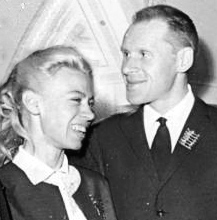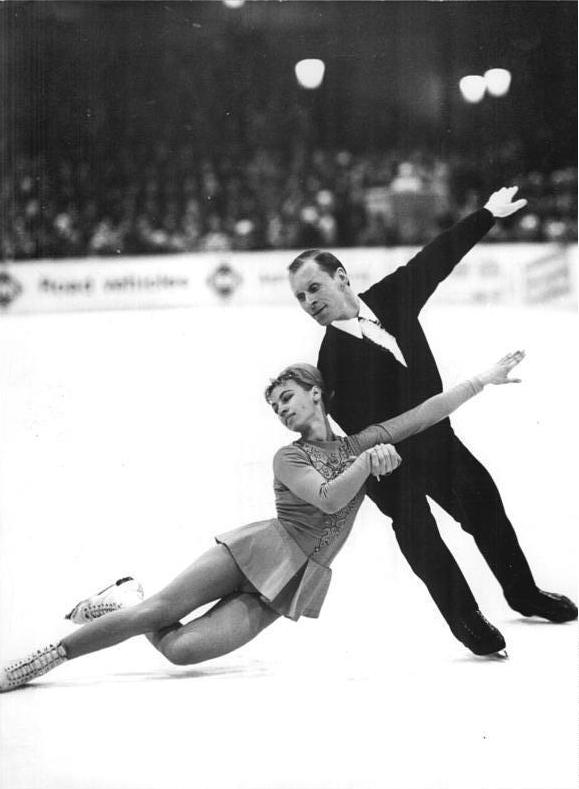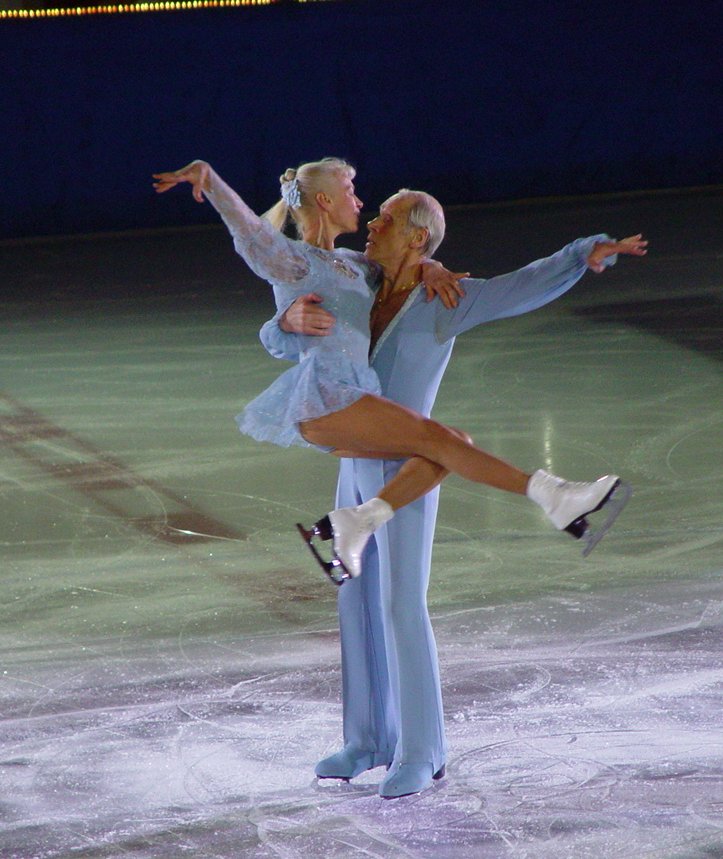1. Overview
Oleg Alekseyevich Protopopov (Олег Алексеевич ПротопоповOleg Alekseyevich ProtopopovRussian; July 16, 1932 - October 31, 2023) was a highly influential Russian pair skater who represented the Soviet Union. Alongside his wife and skating partner, Ludmila Belousova, he achieved unparalleled success, becoming a two-time Olympic champion in 1964 and 1968, and a four-time World champion from 1965 to 1968. Their partnership was renowned not only for its competitive dominance but also for its profound artistic contributions, which elevated pair skating to a new level of balletic expression and introduced innovative elements like new death spirals.
In 1979, Protopopov and Belousova made the significant decision to defect from the Soviet Union to Switzerland, seeking political asylum. They eventually became Swiss citizens in 1995. Despite their defection and subsequent exile, they continued to perform in ice shows and exhibitions well into their seventies, maintaining a lifelong dedication to the sport. Their legacy is marked by their groundbreaking artistry, their competitive achievements, including initiating the Soviet/Russian forty-year Olympic gold medal streak in pair skating, and their enduring impact on the sport's aesthetic and technical development.
2. Early Life and Background
Oleg Protopopov's formative years were shaped by his family and education in Leningrad, Russian SFSR, USSR.
2.1. Childhood and Family
Born on July 16, 1932, in Leningrad, Protopopov was raised by his mother, who was a professional ballet dancer, and his stepfather, the poet Dmitry Tsenzor. This artistic household likely influenced his later emphasis on the balletic and expressive qualities in his skating.
2.2. Education
Protopopov pursued higher education, graduating from Herzen University with a degree from its faculty of physical education. This academic background in physical education complemented his athletic pursuits and likely contributed to his deep understanding of movement and performance.
3. Skating Career
Oleg Protopopov's skating career began relatively late but quickly evolved into one of the most iconic partnerships in figure skating history with Ludmila Belousova, marked by significant competitive victories and artistic innovations.
3.1. Early Skating and Partnership Formation
Protopopov started skating at the age of 15, a comparatively late beginning for a future Olympic champion. His initial coach was Nina Lepninskaya. In 1951, he was drafted into the Baltic Fleet but utilized every opportunity during his leave to continue skating. His first competitive partner was Margarita Bogoyavlenskaya, with whom he secured a silver medal at the Soviet Figure Skating Championships in 1953.
The pivotal moment in his career came in the spring of 1954 when he met Ludmila Belousova in Moscow. Belousova subsequently moved to Leningrad in 1955, and their enduring partnership officially began in 1956 following Protopopov's discharge from the military. The pair trained at the VSS Lokomotiv sports club, representing the Soviet Union internationally. They were initially coached by Igor Moskvin and later by Pyotr Orlov. However, disagreements led them to part ways with Orlov, after which they trained independently at a rink in Voskresensk, Moscow Oblast, without a dedicated coach. In 1961, seeking to enhance their technical difficulty, they decided to collaborate with coach Stanislav Zhuk.
3.2. Competitive Achievements
Belousova and Protopopov made their international debut in 1958, placing 10th at the European Figure Skating Championships and 13th at the World Figure Skating Championships. Two years later, they competed in their first Olympic Games, finishing ninth. Their breakthrough came in 1962 when they earned their first World Championship medal, a silver, becoming the first pair from the Soviet Union or Russia to achieve a world medal since the pair skating discipline was introduced at the 1908 World Championships. Later that year, they also secured a silver medal at the European Figure Skating Championships, marking them as the second Soviet pair to win European medals.

Their first major international gold medal arrived at the 1964 Winter Olympics in Innsbruck, marking the Soviet Union's first Olympic pairs gold. This victory initiated an unprecedented forty-year streak of Soviet/Russian gold medals in pair skating at the Olympics, the longest in the history of Olympic sports, lasting from 1964 to 2006. They continued their dominance by winning their first World and European gold medals in 1965, becoming the first Soviet/Russian pair to claim these titles.
Belousova and Protopopov successfully defended their Olympic title at the 1968 Winter Olympics in Grenoble, securing their second consecutive gold medal. At the time, Protopopov was 35 and Belousova 32, making them among the oldest figure skating champions. In the subsequent season, they earned a silver medal at the 1969 European Championships and a bronze at the 1969 World Championships, as the new era of Irina Rodnina and her partner Alexei Ulanov began. These marked their final appearances at major international competitions, though they continued to compete within the Soviet Union until 1972.
In total, Oleg Protopopov and Ludmila Belousova won two Olympic gold medals and secured medals eight times at both the World and European Championships, including an impressive four consecutive World and European gold medals.
The following tables detail their competitive results:
(with Margarita Bogoyavlenskaya)
| Event | 1953 |
|---|---|
| Soviet Championships | 2nd |
(with Ludmila Belousova)
| Event | 1954-55 | 1955-56 | 1956-57 | 1957-58 | 1958-59 | 1959-60 | 1960-61 | 1961-62 | 1962-63 | 1963-64 |
|---|---|---|---|---|---|---|---|---|---|---|
| Winter Olympic Games | 9th | 1st | ||||||||
| World Championships | 13th | 8th | 2nd | 2nd | 2nd | |||||
| European Championships | 10th | 7th | 4th | 2nd | 2nd | 2nd | ||||
| Soviet Championships | 3rd | 4th | 2nd | 2nd | 2nd | 2nd | 1st | 1st | 1st |
| Event | 1964-65 | 1965-66 | 1966-67 | 1967-68 | 1968-69 | 1969-70 | 1970-71 | 1971-72 | 1972-73 |
|---|---|---|---|---|---|---|---|---|---|
| Winter Olympic Games | 1st | ||||||||
| World Championships | 1st | 1st | 1st | 1st | 3rd | ||||
| European Championships | 1st | 1st | 1st | 1st | 2nd | ||||
| Soviet Championships | 1st | 1st | 1st | 2nd | 4th | 6th | 3rd | ||
| Prize of Moscow News | 3rd | 1st | 2nd |
3.3. Innovations and Artistic Impact

Belousova and Protopopov significantly contributed to the evolution of pair skating by introducing new elements and elevating the sport's artistic expression. They are credited with creating three distinct death spirals: the backward inside death spiral, which they named the "Cosmic spiral"; the forward inside death spiral, called the "Life spiral"; and the forward outside death spiral, known as the "Love spiral". These innovations showcased their creativity and technical prowess.
Beyond new elements, their impact was most profoundly felt in their ability to translate classical dance to the ice. Figure skating writer and historian Ellyn Kestnbaum noted that they "raised by several degrees the level of translating classical dance to the ice." Similarly, figure skating historian James R. Hines stated that the Protopopovs "changed dramatically the direction of pair skating, making it more balletic." Their performances were characterized by a seamless flow, intricate choreography, and an emphasis on the emotional narrative, often conveying romantic heterosexual love. As Kestnbaum observed, "Their performances set a benchmark for romantic heterosexuality on the ice and for classical line and expressiveness that influenced not only pair skating but also singles and [ice] dance." Legendary skater Dick Button lauded their contributions, stating, "The Protopopovs are great skaters not only because they were the finest of Olympic champions, but also because their creative impact was extraordinary."
4. Defection and Later Life
The lives of Oleg Protopopov and Ludmila Belousova took a dramatic turn with their defection from the Soviet Union, leading to a new chapter in Switzerland and a continued dedication to skating.
4.1. Defection to Switzerland
On September 24, 1979, while on tour, Oleg Protopopov and Ludmila Belousova made the momentous decision to defect from the Soviet Union. They sought political asylum in Switzerland, a move that reflected their desire for greater artistic freedom and a life unconstrained by the Soviet regime. This defection was a significant event, given their status as celebrated Olympic champions.
4.2. Life in Exile and Citizenship
After their defection, Protopopov and Belousova settled in Grindelwald, Switzerland, which became their winter home. They eventually received Swiss citizenship in 1995, solidifying their new life in exile. In addition to their Swiss residence, they maintained a summer home and training center in Lake Placid, New York, allowing them to continue their rigorous training regimen.
4.3. Continued Skating and Visits to Russia

Even after retiring from competitive skating, the pair continued to perform together in ice shows and exhibitions for many years, showcasing their enduring grace and artistry. In September 2015, they renewed a long-standing tradition by skating in a charitable exhibition in Boston, Massachusetts, at an event titled "Evening with Champions."
A significant moment in their later life was their return to Russia. On February 25, 2003, they visited their homeland for the first time in 23 years, after a long period of exile, at the invitation of Vyacheslav Fetisov, a prominent Russian sports figure. They also attended the 2014 Winter Olympics in Sochi, Russia, demonstrating a reconciliation with their past. Their final exhibition dance performance took place in 2016, when Protopopov was 84 years old, a testament to their lifelong passion for skating.
5. Personal Life
Oleg Protopopov's personal life was deeply intertwined with his professional one, particularly through his marriage to his skating partner.
5.1. Marriage to Ludmila Belousova
Oleg Protopopov married Ludmila Belousova in December 1957. Although Belousova chose to retain her maiden name after their marriage, the pair was widely and affectionately known as "The Protopopovs." Their shared passion for figure skating was so profound that they made a joint decision not to have children, prioritizing their careers and dedication to the sport. This commitment allowed them to fully immerse themselves in their training and performances, contributing to their remarkable success and longevity in the world of figure skating.
6. Death
Ludmila Belousova passed away on September 29, 2017, at the age of 81. Oleg Protopopov died on October 31, 2023, at the age of 91, in Interlaken, Bern, Switzerland. Reports indicated that he died peacefully in his sleep. The news of his passing was officially announced by the Russian Olympic Committee. Both Oleg Protopopov and Ludmila Belousova were buried together in Saint Petersburg on September 11, 2024, bringing their lifelong partnership to a final resting place in their homeland.
7. Legacy and Honors
Oleg Protopopov's enduring influence on figure skating is widely recognized, both through formal honors and the lasting impact of his artistic vision.
7.1. World Figure Skating Hall of Fame
In recognition of their groundbreaking achievements and profound contributions to the sport, Oleg Protopopov and Ludmila Belousova were inducted into the World Figure Skating Hall of Fame in 1978. This prestigious honor acknowledges their status as pioneers and legends in figure skating.
7.2. Impact on the Sport
The Protopopovs left an indelible mark on pair skating, fundamentally altering its direction and raising its artistic standards. Their innovative approach included the creation of three new death spirals-the backward inside ("Cosmic spiral"), forward inside ("Life spiral"), and forward outside ("Love spiral")-which expanded the technical vocabulary of the discipline. More broadly, they were instrumental in making pair skating more balletic, seamlessly integrating elements of classical dance and expressive movement into their routines. Their performances set a benchmark for romantic expression and classical lines on the ice, influencing not only pair skating but also singles and [ice] dance. Their legacy is defined by their ability to blend athletic prowess with profound artistry, inspiring generations of skaters to pursue both technical excellence and emotional depth in their performances. In 1968, they were also jointly awarded the BBC Overseas Sports Personality of the Year award.